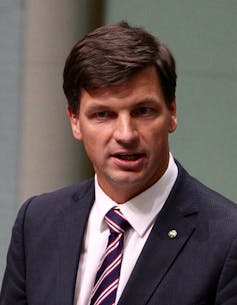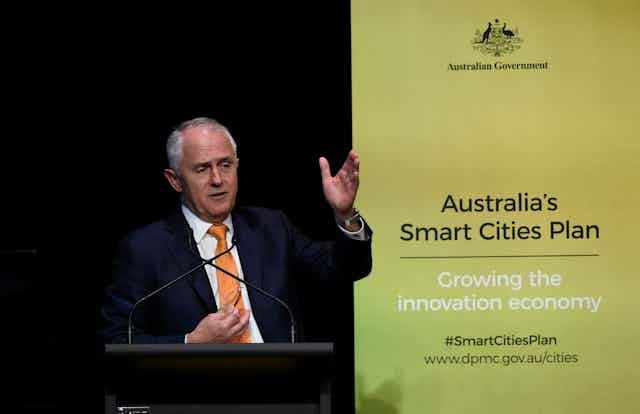For committed urbanists, any sign of serious urban policy action by the federal government is welcome. Early announcements by Prime Minister Malcolm Turnbull and his appointment of a minister for cities were cause for some celebration.
The subsequent appointment of Angus Taylor as assistant minister for cities and digital transformation continued the positive outlook; a relatively new parliamentarian with a good track record of business development and an analytical disposition was entrusted to advance this policy agenda.
April 29 marked the start of the next phase of policy development, when we got to see what a Smart Cities Plan looks like and whether it was worth the wait.
On first reading it contains all of the right words – smart, innovative, liveability and prosperity. It also advocated some sensible principles – collaboration, co-operation and partnership. But do these nice words and sensible principles add up to a real step change in urban policy thinking, or to a business-as-usual approach wrapped in the latest policy terminology?
At this stage we cannot be sure, but prospective partners in state and local government seem to have a fair degree of optimism about the plan.
Most sensible public bodies will profess their support, in principle, for any initiative that offers the prospect of new money to support development proposals in their area. They will commit, in principle, to working together for the common good in their locality. And, if necessary, they will rebadge their current plans to fit more easily with the rhetorical flavour of the new initiative.
The proof will, however, lie in the detail of partnership arrangements, in the implementation structures that are developed and in the way new money is allocated. Even more importantly, success will depend on whether the actual measures employed work in practice.
Partnerships in practice
In each of our cities – large and small – we need all three levels of government to work together if growth is to be supported and managed effectively. Intergovernmental partnerships have been proposed for as long as we have had different levels of government.
There is much research on what makes such partnerships work well and what does not. Where partnerships work, much of this success is based on mutual respect and recognition of the distinctive contribution of each partner.
It becomes more challenging where the reality of an urban area requires horizontal partnerships between local councils as well as vertical partnerships with state and federal bodies.
The patchy experience of Regional Development Australia committees across the country gives some indication of how well this has been achieved to date. Some have worked very well. Others have struggled in the face of varied and variable enthusiasm among partners.
Getting implementation structures right

I have argued previously that effective implementation of any policy initiative is often plagued by a lack of long-term commitment and bipartisan support.
Along with a seemingly irresistible belief within governments of any hue that policies need to be fiddled with (the technical terms would be refreshed, refocused or rebadged) every few years, carefully designed initiatives are rarely left to get on with their work and run their course.
Another problem is bureaucratic capture, in which early ambitions to work differently, with greater agility perhaps, are slowly but surely overtaken by implementation regimes that do the opposite in practice. The business experience of both the prime minister and his assistant minister for cities will be needed to prevent this type of sclerosis taking hold.
Finding and spending new money to best effect
As Taylor told Michelle Grattan recently, some partnerships between public bodies and private investors have been very effective in the past – the construction of the national rail network in the US, for example. But there is also no shortage of ones that have not gone well for any of the parties.
So, while there has been some enthusiasm for the potential role of value capture of late – and certainly in the new plan – we need to see the detail of particular proposals.
The UK City Deals model includes the principle of transferring some of the increased tax revenue associated with growth from the Treasury back to local partnerships. However, this has sometimes proved difficult to agree in practice.

And it is here that bipartisan agreement in the urban policy field seems unlikely at present. The shadow minister for cities, Anthony Albanese, has come straight out with a ringing condemnation of the Turnbull-Taylor plan as a policy without substance.
Albanese also joined with the Property Council of Australia in invoking the spectre of Australian families being slugged with a new property tax to capture some of any increased value associated with public investment in infrastructure.
How will we know what works?
Tucked away on page 23 of the plan is a small section about measuring success. This acknowledges the importance of having good-quality data to provide a baseline against which future performance can be measured. It cites the need for “unambiguous targets, accountabilities and timeframes for city-level reforms”.
The plan recognises that, without these, it will be impossible for the government to hold itself and its investment partners to account. I would like to think that in five years’ time we will be able to read a National Audit Office report (like this one on the 2011-14 Liveable Cities Program) describing how this bold new Smart Cities Plan heralded a new era of productive intergovernmental collaboration.
That would mean it succeeded in attracting substantial new private investment, which set our cities on a clear path to being smarter, more productive and nicer places in which to live.
Let’s hope that if I shared this view with The Castle’s Darryl Kerrigan he wouldn’t tell me, or indeed Angus Taylor, that we’re dreamin’.

